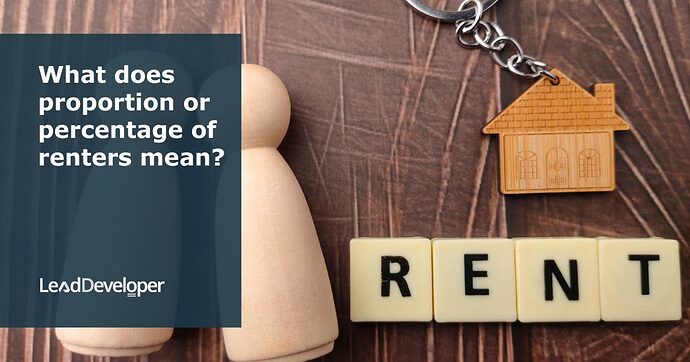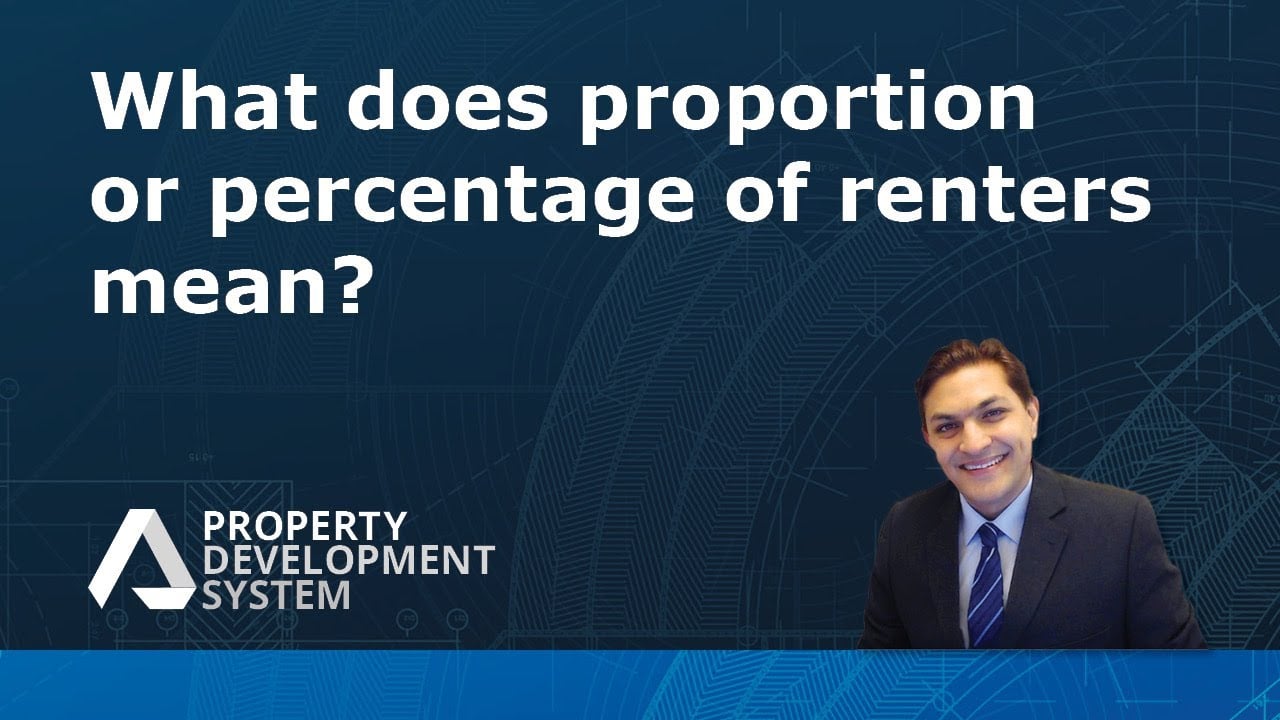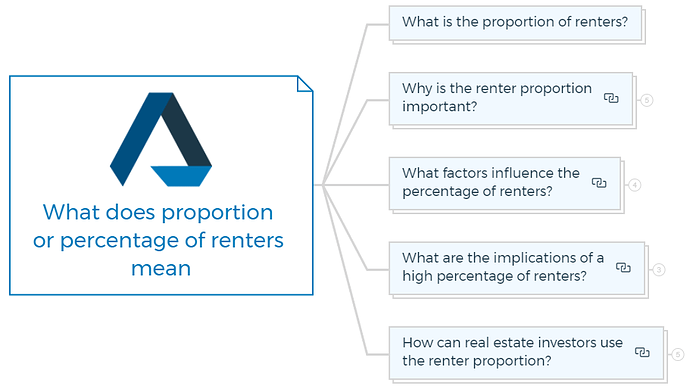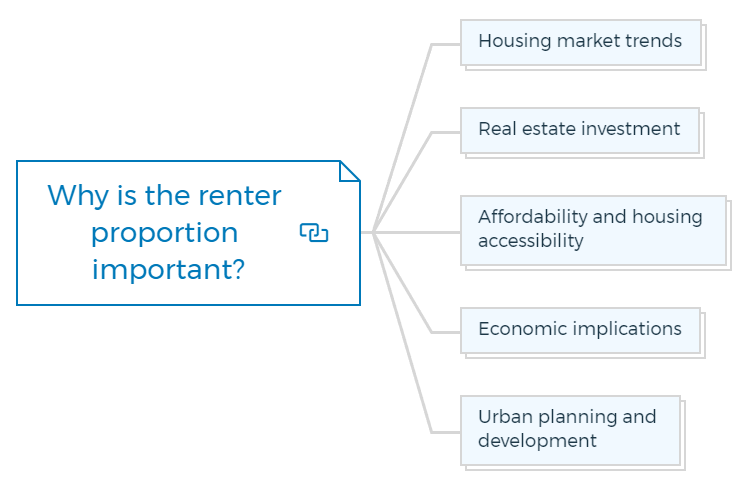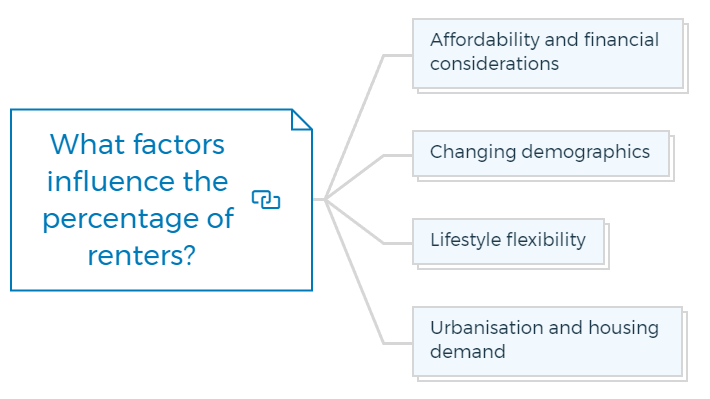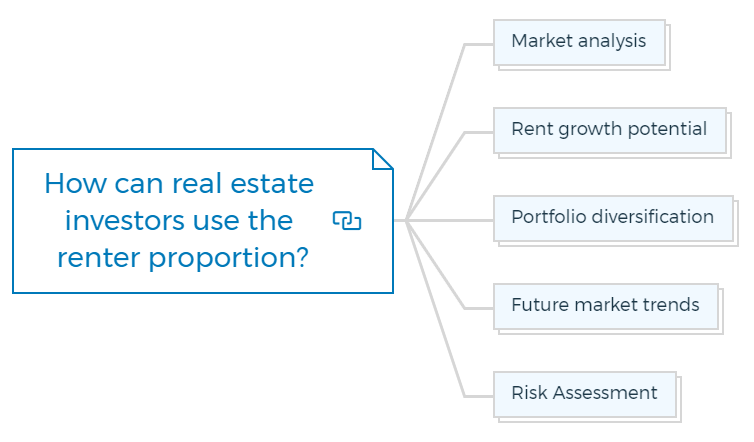What does the proportion or percentage of renters mean?
The proportion or percentage of renters is a crucial metric that shows insights into a region’s housing market. It represents the percentage of renters in the population.
In recent years, there has been a notable shift towards rental housing, with an increasing number of people opting to rent rather than pursue homeownership.
What is the proportion of renters?
The percentage of renters refers to the ratio of individuals or households who rent their homes to the total population of a specific area, expressed as a percentage.
Divide the number of occupied rental units by the region’s total occupied dwelling units to get this statistic. It is a key indicator of rental housing in a neighbourhood.
As a general rule of thumb, 30% of the property owners are investors. The suburbs with fewer renters are considered a safe and secure investment plan as well as it evokes a sense of supply since most of the people in that location are owners.
The lower the proportion of renters, the lower the vacancy rate is likely to be.
Moreover, the lower the percentage of renters, the lesser the supply of rental accommodation is there. This signifies a better living standard and quality of life.
You are missing out if you haven’t yet subscribed to our YouTube channel.
Why is the renter proportion important?
Renter proportion, or the percentage of renters in a market or area, is an important indicator with several consequences. Renter proportion is significant for these reasons:
Housing market trends
Renter proportion reveals housing market trends. It measures rental demand and market health. More renters indicate a healthy rental market.
Real estate investment
Real estate investors must consider the renter proportion. More tenants may signal strong rental demand and increase rental property investment options.
Investors might consider renter proportion, rental rates, and market conditions when making investment selections.
Affordability and housing accessibility
Renter proportion can indicate housing affordability and accessibility. Renters may indicate affordability issues in areas with high property costs or restricted financing options.
It emphasises the need for affordable rental accommodation for low-income households.
Economic implications
The renter’s share has multiple economic effects. Property management, maintenance, and allied businesses create jobs in a strong rental market. Rental income also boosts local economies through spending and investment.
Urban planning and development
Renters affect urban planning and development. It helps policymakers, and property developers build and improve rental buildings in high-demand areas.
It also coordinates infrastructure, transportation, and community service resource distribution to meet tenant demands in specific locations.
What factors influence the percentage of renters?
Affordability and financial considerations
Renters are rising due to affordability. Rising housing costs, strict mortgage regulations, and limited credit have made homeownership difficult for many individuals.
Renting provides a more flexible and financially viable option, allowing individuals to allocate their resources towards other priorities such as education, investments, or starting a business.
Changing demographics
Renters are rising due to changing demographics. Millennials and Generation Z prefer renting to owning. Increased mobility, delayed marriage and family formation, and urban living influence this option.
For ease and lower maintenance, an aging population may downsize and move to rentals.
Lifestyle flexibility
Renting appeals to many people. Renters might move for work or personal reasons without selling a property. It provides a more flexible lifestyle, especially for young professionals and students.
Urbanisation and housing demand
Rapid urbanisation has increased housing demand, especially in cities. Many urban dwellers rent due to limited housing supply and escalating property prices. Renting puts people closer to jobs, facilities, and culture, improving their quality of life.
What are the implications of a high percentage of renters?
Rental market growth
Renters indicate a strong rental market with ongoing demand. This offers real estate investors and property owners rental income and increased returns on investment.
A strong rental market boosts economic activity, property management and maintenance jobs, and local tax income.
Housing affordability challenges
High renter rates may imply housing affordability and homeownership issues. Aspiring homeowners may struggle to buy in areas where property prices surpass wage growth.
This emphasises the necessity for government programmes like affordable housing, rental aid, and homeownership affordability.
Community dynamics and stability
The percentage of renters affects community dynamics and neighbourhood stability. Rental communities have higher turnover rates than owner-occupied places, which might affect social cohesion.
Well-managed rental buildings can still promote community engagement and belong through property management and tenant interaction.
How can real estate investors use the renter proportion?
Investors can utilise the renter proportion as a valuable metric to inform their real estate investment strategies.
Investors can use renter percentages in numerous ways:
Market analysis
The renter proportion shows rental property demand in a market. Renter proportion, rental rates, vacancy rates, and population growth can help investors determine rental property profitability.
Higher renter proportions indicate a healthy rental market and high demand for rental units.
Learn More
Rent growth potential
More renters may indicate a competitive rental market, allowing landlords to raise rents over time.
Investors can evaluate rental property revenue potential and long-term viability using renter proportion, rental rate trends, and local economic indicators.
Portfolio diversification
The renter proportion can help real estate investors to diversify their portfolios. Investors can reduce risk and avoid overexposure to homeownership markets by investing in markets with different renter proportions.
Learn More
Future market trends
The renter proportion can reveal market and demographic shifts. If young professionals or retired baby boomers rent more in a particular location, investors might anticipate shifting housing needs and adjust their investment plans.
Investors can satisfy rental property demand by anticipating demographic changes.
Risk Assessment
Renter proportion helps investors estimate market risks in specific locations. Renter-heavy markets may be more vulnerable to economic downturns and rental demand shifts.
Investors can assess risks and returns by researching the renter share, job development, local industries, and rental legislation.
Test Your Knowledge
Assignment: Analyzing Renter Proportion in the Housing Market
Objectives:
- Understand the significance of renter proportion in the housing market.
- Analyse how renter proportion impacts real estate investment decisions.
- Explore the implications of high renter proportions on communities and economies.
Instructions:
This assignment consists of research tasks, analysis questions, and practical exercises. You will use publicly available data, academic resources, and local government reports to complete this assignment. Assume you are analyzing your local housing market unless otherwise stated.
Part 1: Data Collection and Analysis
- To Do: Collect data on your local housing market, focusing on the proportion of renters. Identify sources of this information, such as census data, local government reports, or real estate websites.
- Question: What is the current renter proportion in your local market? How does it compare to the national average?
- To Do: Identify three neighborhoods with varying renter proportions. Note the differences in renter proportions and speculate on the reasons behind these variations.
Part 2: Implications of Renter Proportions
- Research Question: How does a high proportion of renters affect housing affordability in your area? Use specific examples or data to support your answer.
- To Do: Analyse the impact of renter proportions on community dynamics and neighbourhood stability. Interview local real estate experts or community leaders for insights, if possible.
- Question: Discuss the potential economic implications of a growing renter population in your area. Consider aspects such as job creation in property management and local spending.
Part 3: Real Estate Investment Analysis
- To Do: Using the concept of renter proportion, conduct a market analysis for a potential real estate investment in your area. Include factors such as renter proportion, rental rates, vacancy rates, and population growth.
- Question: Evaluate the rent growth potential in an area with a high proportion of renters. How does the competitive rental market influence your investment strategy?
- Research Question: How can an investor use renter proportion to assess risk and diversify their investment portfolio? Provide a hypothetical example of portfolio diversification based on renter proportion data.
Part 4: Future Market Trends
- To Do: Identify a demographic trend (e.g., increase in millennials renting) in your area and analyze its potential impact on future housing needs and renter proportions.
- Question: Predict how changes in renter proportions could influence urban planning and development strategies in your area over the next decade.
Submission Requirements:
- Compile your findings, analyses, and speculations into a comprehensive report.
- Include citations for all data and resources used.
- Incorporate charts or graphs to represent data analysis where applicable visually.
- Conclude with a reflection on how this assignment has altered your perception of the housing market and real estate investment.
